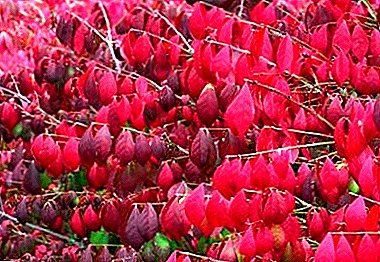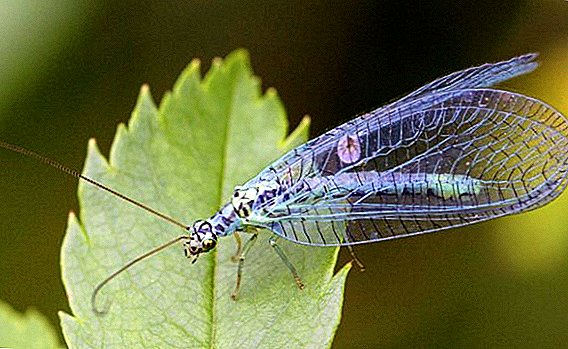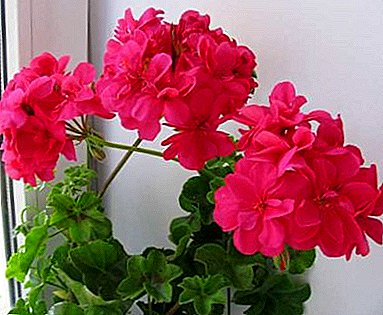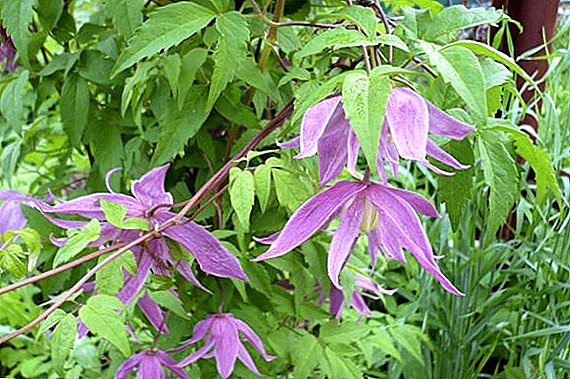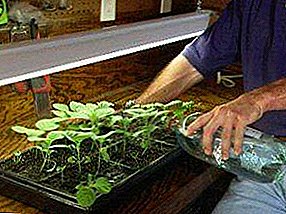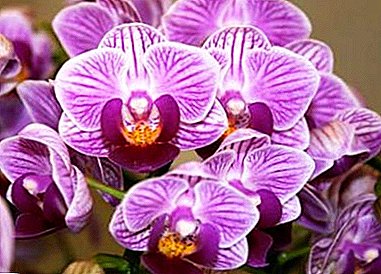
Sogo orchid flowers are special, they fascinate and conquer absolutely everyone who once saw them. Of course, to get this luxury, you need to work hard, try to create all the conditions for this orchid.
This beautiful flower appeared as a result of the work of experienced breeders. In our article we will talk about the conditions for growing orchids and the rules for caring for them. You can also watch a useful video on this topic.
Brief Definition
Sogo orchid - a kind of phalaenopsis, obtained as a result of many crosses. Belongs to the ancient family of orchids, this epiphytic orchid, that is, loves stones, mountain gorges, tropical forests, is located on stumps and other trees.
Detailed description
 Sogo orchid - phalaenopsis with large flowers. This hybrid is characterized by abundant flowering, a series of flowers. A special type of peduncles is very long, it grows in a cascade, at home special supports are necessary to ensure uniform cultivation of flowers, they receive the same amount of light and heat.
Sogo orchid - phalaenopsis with large flowers. This hybrid is characterized by abundant flowering, a series of flowers. A special type of peduncles is very long, it grows in a cascade, at home special supports are necessary to ensure uniform cultivation of flowers, they receive the same amount of light and heat.
The leaves are large, oblong, grow up to 35-40 cm, dark green, dense, even harsh, as if covered with glitter. Sogo orchids are distinguished by large saturated colors., covered with flickering spray, the color is the most diverse: from white to light crimson, purple.
History of
The homeland of the ancestors of the Sogo Orchid is Australia, Southeast Asia, the Philippines. The history of the discovery of this miracle goes far in the XIX century. Professor and owner of the botanical garden Karl Blum first saw an unusual plant, traveling through the Malay Archipelago. Exotic flowers were so similar to bright butterflies that they have since called this type of phalaenopsis orchids, which means "moth, butterfly".
What is the difference from other species?
Sogo orchid is a hybrid, a mixture of several varieties. The peculiarity of an orchid is that it is unpretentious, it is enough just to care for it, observing proper watering, temperature and lighting. It can bloom several times a year. Flower spike is very long, so the flowers themselves are located in a beautiful cascade. The leaves are wide, dense, hard.
May be monochrome, dark green and may be motley. It grows from 20 to 40 cm, depending on the variety and age of the orchid. Sogo does not tolerate stuffiness and dampness, ventilation is necessary, even in winter there should be good air circulation. But beware of drafts.
Podort and their photos
The varieties of Sogo orchid are Yukidan and Vivien.
Yukidan

Yukidan flowers look like elegant figures - elongated, slender. The colors are delicate - white, pink, they grow up to 12-14 cm in diameter. The petals are round, widespread, as sugar, shimmer in a good light. Lips curly, small, look like a pattern-brooch against the background of pale pink or white flower. The leaves are rather wide, monophonic, bright green in color, with a longitudinal vein in the middle, dense, glossy.
We recommend to watch the video about the features of the appearance of the orchid Sogo Yukidan:
Vivien

Charming Asian beauty. Leaves unusual, decorated with variegated, bordered with a lighter color than the whole dark green, rich leaf. The leaves are dense, shiny, rounded. The flowers themselves are unusual, elegant, shimmering, as if sprinkled with a shiny filling. Pink, with crimson veins, motley and festive. The lips are bright, medium, curly. With the growth of this orchid turns into a beautiful bouquet, like phalaenopsis multiflora.
We recommend to watch a video about the features of the appearance of the Sogo Vivien orchid:
Bloom
When and how?
Sogo blooms at any time of the year, very much, beautifully, large, up to 15 cm in color. It flourishes in a cascade of garlands, which is the main feature of this phalaenopsis variety.
Care before and after blooming buds
Before the blooming of the Sogo orchid, you need to comply with the temperature regime - 22-25 ° C during the day and a slight drop to 18-20 ° C at night. Orchid loves soft light, so you need to provide additional lighting in the winter for 1 to 2 hours to increase the light day. Additional lighting is used.
What if it does not bloom?
The main reason is improper watering. Be sure to dry the substrate between waterings. To encourage orchid flowering, there should be a natural temperature difference.. In the summer, this is obtained naturally, but in winter and autumn it is necessary to ensure that the temperature decreases at night by at least 4-5 ° C. But do not get carried away with fertilizers, often this excessive fertilizer suppresses Sogo's flowering orchids.
Step-by-step care instructions
Choosing a place
This orchid is very afraid of the open rays of the sun. Experienced collectors are advised to place it on the north windows, adding lighting.
Soil preparation and pot
 The pot is better to take a transparent plastic, in the side parts and at the bottom we make small holes for good air access and for convenient location of the roots. The pot should not be very large, it should serve to support the roots, so choose medium-sized pots.
The pot is better to take a transparent plastic, in the side parts and at the bottom we make small holes for good air access and for convenient location of the roots. The pot should not be very large, it should serve to support the roots, so choose medium-sized pots.
Substrate:
- Drainage - pieces of polystyrene foam or expanded clay, located at the bottom of the pot.
- Charcoal - chopped pieces can be placed in the moss between the roots.
- Moss - sphagnum retains moisture well and is a natural medium for orchids.
Temperature
The orchid is thermophilic, it is desirable that the temperature does not fall below 20 ° C during the day, no matter what time of year outside the window. Then it will grow well, grow, grow young leaves and soon it will blossom again.
Important: The Sogo Orchid does not like heat, the optimum temperature is up to 28 ° C.
Humidity
Sogo orchids do not require too much moisture, 50-60% is enough. They tolerate drying better than flooding. But in spring and summer it is necessary to increase the humidity. This will ensure good growth and blooming of orchids. Additional moisture is not required, simply refresh the leaves in hot weather by spraying.
Lighting
Sogo orchid, like all hybrid varieties of Phalaenopsis, is not capricious. Does not require any special fixtures in the lighting. In spring and summer, be sure to darken the windows so that the sun does not burn the leaves of the orchid. Additional lighting is required in winter, special fitolamps can be used.
Watering
 If orchids are located on the northern windows, naturally, watering is not needed as often as if orchids were located in a “warmer” window. It is important to observe the roots. If the roots are grayish brown, you can water them.
If orchids are located on the northern windows, naturally, watering is not needed as often as if orchids were located in a “warmer” window. It is important to observe the roots. If the roots are grayish brown, you can water them.
It is better not to water the flowers, not to spray them, so that the spots do not appear on them, and the leaves can be sprayed, moisturizing and airy roots. It is enough once in 2 weeks in the autumn-winter period, and if it is very hot, then once a week.
We recommend to watch the video about the correct watering of orchids:
Top dressing
Feed your Sogo orchid normally with watering. It is recommended for flower growers to water with any special constrictor. Fertilizer mode: alternating irrigation with simple water with irrigation with fertilizer. As soon as the kidneys appear, water only with water, without fertilizer. The main thing - do no harm.
Transfer
- You will need to get the orchid out of the pot, then soak the orchid together with the earth clod in a solution of epic and succinic acid. Coconut chips and moss - sphagnum is also soaked.
- It is transplanted by transshipment with the original substrate (if the orchid is healthy).
- If there are diseased, decomposed roots, then you will need to clean the roots.
- We drop the updated and processed orchid in a new pot.
- Ready substrate, not pushing, fill the space of the pot.
- We install an orchid in a large container, water it well, so that moisture penetrates into the whole new substrate. Excessive water gradually flows through the holes. With a wadded disc, we remove water from the leaflets and growth points to avoid rotting.
We recommend to watch the video about the features of the Sogo orchid transplant:
How to multiply?
In the greenhouse, the Sago orchid is propagated by seeds and sprouts that appear after flowering. And you can grow your own orchid "kids" - small growths. It is better to multiply the orchid in late winter or early spring. The main condition is to do it after flowering.
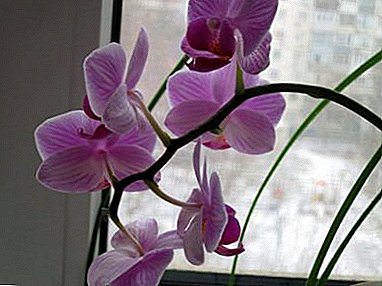 First of all, you need to choose an adult, with a good healthy root, large orchid leaves.
First of all, you need to choose an adult, with a good healthy root, large orchid leaves.- With a sharp, clean, pretreated knife on the stalk the tip is incised to a sleeping kidney, the incision is sprayed with charcoal or cinnamon for disinfection.
- We transplant a new sprout into a pre-cooked small pot with the necessary substrate.
- Prepare the soil in advance: a substrate of tree bark and moss is shed for 2 to 3 minutes with boiling water for disinfection.
- Watering should stop for a few days, the plant needs to recover.
Diseases and pests
- Spider mite It reproduces very quickly, catching the whole orchid with cobwebs. It is recommended that flower growers spray this with a phytoverm solution. It requires at least 3 sessions with a break from 7 to 8 days.
- Different rot formed in the axils of the leaves, in the roots and on the peduncle, if the air stagnates, the room is not ventilated, the air circulation is disturbed, and the temperature decreases. It is better to immediately transplant the orchid, clean the root of rotten roots, you must change the infected substrate, stop watering for a while. Roots smeared with foundation, sprinkled with coal on the "wound".
Board: For processing pots and tools, you must use a solution of copper sulfate.
We recommend watching a video about orchid diseases and pests:
Conclusion
Erich Hansen, in his famous book "Orchid Fever," noted the following pattern: "If you are addicted to orchids, they cannot be discarded. Never." You should not argue and argue - better and more precisely you will not tell. May your orchids be healthy and bring joy and comfort to your home.


 First of all, you need to choose an adult, with a good healthy root, large orchid leaves.
First of all, you need to choose an adult, with a good healthy root, large orchid leaves.